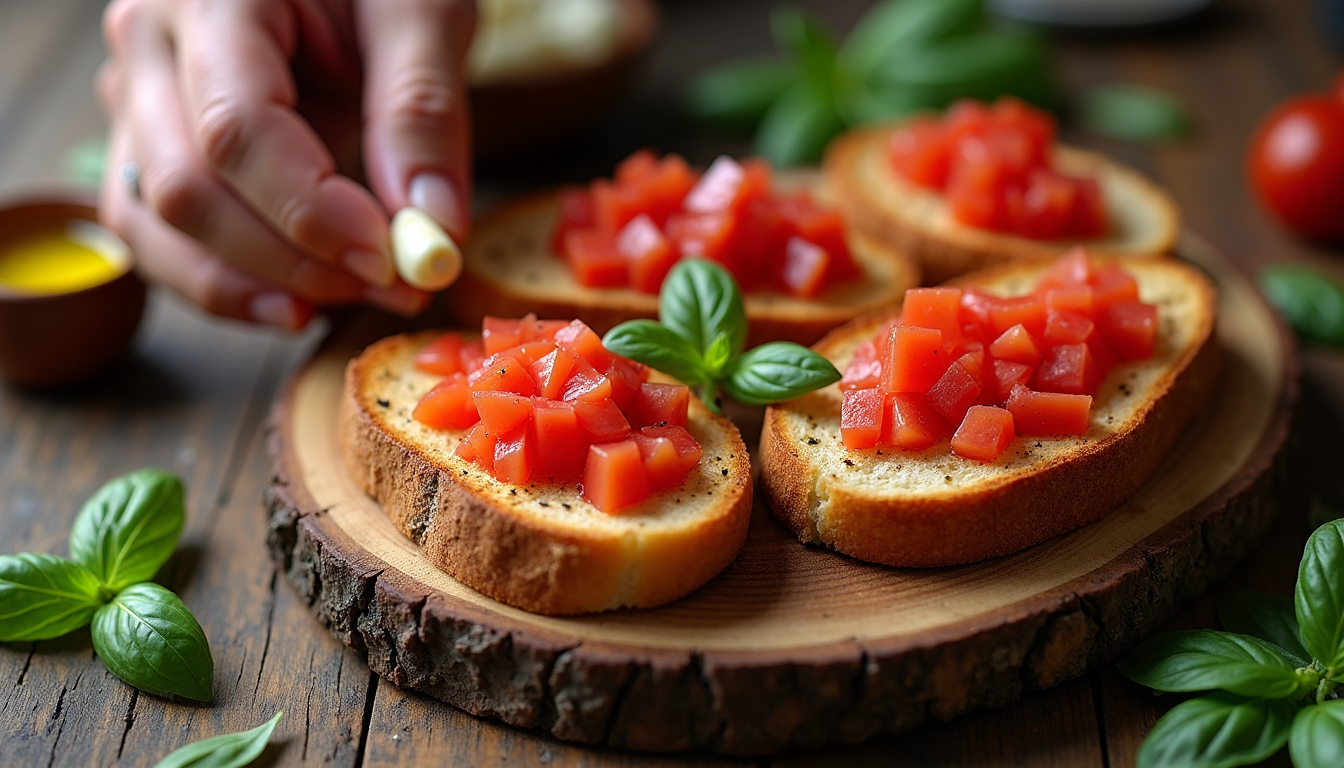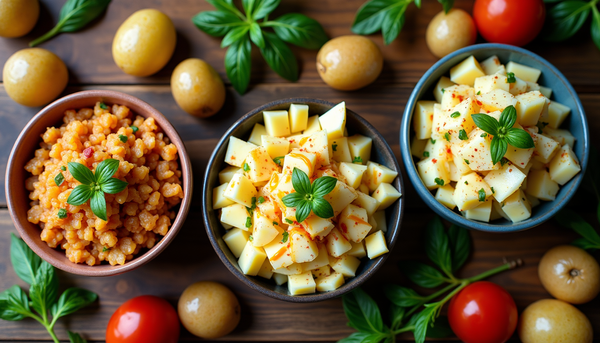Stop Ruining Bruschetta: What Every American Gets Wrong About Italy's Perfect Peasant Food

Look, I need to get something off my chest. Every time I see another restaurant serving bruschetta topped with sun-dried tomatoes, pesto, and whatever random cheese they found in the walk-in cooler, a little part of my nonna's soul dies. And mine too, honestly.
We've completely lost the plot on what bruschetta actually is. It's not a fancy appetizer designed to showcase your "creativity." It's not a vehicle for your leftover ingredients. And for the love of all that's holy, it's definitely not pronounced "brew-SHET-ta."
The Summer That Changed Everything
I was twelve when I first understood what real bruschetta could be. My family was visiting my great-aunt Giulia in her tiny village outside Siena. It was August, brutally hot, and the tomatoes in her garden were so ripe they practically fell off the vine if you looked at them wrong.
Aunt Giulia took one look at the sad, store-bought bread we'd brought from town and clicked her tongue in that disapproving way only Italian women have mastered. "Bah. Too fresh," she muttered, tossing it into a basket and pulling out yesterday's pane pugliese—crusty, day-old, perfect.
What happened next was pure magic disguised as simplicity. Five ingredients. Maybe ten minutes of actual work. But the result? It was like tasting summer itself, concentrated into each perfect bite.
That's when I realized that bruschetta isn't about what you add to it. It's about what you don't add. It's about restraint. About letting each element sing its own note in perfect harmony.
The Foundation: Why Most Bruschetta Falls Flat
Here's the thing most people don't understand—great bruschetta starts with failure. Not yours, but the bread's. You need bread that's lost its first blush of freshness, that's developed some character, some backbone. Fresh bread is too soft, too eager to please. Day-old bread? Now that's got attitude.
My nonna used to say, "Il pane invecchiato ha storie da raccontare"—aged bread has stories to tell. And bruschetta is how it tells them.
But let's be real—most of us aren't baking fresh bread daily (though if you are, I respect that life choice). So here's what you need to know about choosing your foundation:
The bread matters more than you think. Skip the pre-sliced stuff from the grocery store. Find yourself a proper baguette or ciabatta—something with a real crust that fought for its life in the oven. Cut it thick. About three-quarters of an inch. Thin slices are for amateurs who care more about Instagram than flavor.
Toast it properly. This isn't about warming bread. This is about creating texture, about building layers of flavor through the Maillard reaction. You want golden brown with some darker spots—those little charred areas are flavor bombs waiting to happen.
The Soul of the Dish: Tomatoes That Actually Taste Like Something
Now we get to the heart of it all. And I'm going to be brutal here—if your tomatoes suck, your bruschetta will suck. There's no hiding behind fancy olive oil or artisanal salt when your tomatoes taste like wet cardboard.
I don't care if it's December and you're craving bruschetta. Wait. Make something else. Because mediocre tomatoes don't become good tomatoes just because you put them on toasted bread.
When tomato season hits—really hits, when farmer's market vendors are practically giving away boxes of perfectly ripe fruit because they can't sell them fast enough—that's your moment. That's when you make bruschetta.
Here's what you're looking for: tomatoes that smell like tomatoes when you hold them close. Ones that give slightly to pressure but aren't squishy. And please, for everything sacred, choose flavor over appearance. Those perfectly round, perfectly red supermarket tomatoes? They're beautiful and they're boring.
Size matters, but not how you think. Small tomatoes—cherry, grape, even those cluster tomatoes still attached to their vines—often pack more concentrated flavor than their larger cousins. Roma tomatoes work beautifully too. But those giant beefsteak tomatoes? Save them for something else.
Prep them with respect. Core them properly—don't just hack at them. You want clean, small dice. Not chunks, not slices, not a rustic chop. Uniform pieces that will sit properly on the bread and distribute flavor evenly.
And here's a trick that separates the real cooks from the recipe followers: salt your diced tomatoes and let them drain for fifteen minutes. This draws out excess water that would otherwise make your bread soggy and concentrates the tomato flavor. Some people think this is unnecessary. Those people are wrong.
The Supporting Cast: Every Ingredient Earns Its Place
Let's talk about olive oil. Not all olive oils are created equal, and for bruschetta, you need the good stuff. I'm talking about extra virgin that actually tastes like olives, that has some personality, some bite. This isn't the time for your everyday cooking oil.
My preference? Something with a little pepper to it, something that makes you notice it's there. Tuscan oils work beautifully, but so do many Spanish and Greek varieties. The key is finding one you'd be happy to eat with a spoon—because essentially, that's what you're doing.
Basil isn't decoration. It's not there to make your bruschetta look pretty on Instagram. It's a flavor component, and it needs to be treated as such. Fresh basil only—and I mean picked-that-day fresh if possible. Dried basil on bruschetta is like wearing a tuxedo with flip-flops. Technically possible, but missing the point entirely.
Tear it, don't cut it. Those dark spots you get from cutting basil with a knife? They taste like regret. And add it at the last minute—basil wilts fast and oxidizes faster.
The garlic game-changer. Here's where most people go completely off the rails. They mince garlic into the tomato mixture, or worse, they skip it entirely. Both approaches miss the beauty of the traditional method.
Cut a clove of garlic in half. Rub the cut side directly onto the warm, toasted bread. That's it. The rough surface of the bread acts like a grater, releasing just enough garlic oil to perfume each slice without overwhelming it. It's subtle. It's sophisticated. It works.
Start light—you can always add more, but you can't take it back once you've gone overboard.
The Secret Ingredient That Isn't Secret At All
Oregano. Specifically, dried oregano.
I know, I know. We've been trained to think fresh herbs are always superior. But in this case, dried oregano brings something to the party that fresh can't—a concentrated, almost floral earthiness that bridges the gap between the bright tomatoes and the rich olive oil.
Just a pinch. Seriously. We're talking about maybe a quarter teaspoon for enough tomato topping to serve six people. This isn't oregano chicken. This is seasoning in the truest sense—enhancing what's already there without announcing its presence.
The Assembly: Where Good Intentions Go to Die
This is where most people screw it up. They get excited, they pile the tomato mixture onto the bread, and they serve it immediately. Or worse—they assemble everything hours ahead "to save time."
Both approaches guarantee soggy bread. And soggy bread is the enemy of good bruschetta.
Here's the correct sequence: warm bread gets the garlic treatment first, while it's still hot from the oven. This is crucial—the heat helps release the garlic oils and creates maximum flavor absorption.
Then you wait. Let the bread cool slightly so it won't immediately wilt your tomato mixture. But not too much—you want some residual warmth.
The tomato mixture should be at room temperature. Not cold from the fridge, not warm. Room temperature lets all the flavors meld properly while ensuring the basil doesn't immediately surrender to heat.
Apply the topping just before serving. Not five minutes before. Not "while guests are taking off their coats." Right before it goes in someone's mouth.
When Breaking Rules Actually Works
Now, after I've spent all this time preaching tradition, let me tell you when it's okay to innovate.
The cheese question. Traditional bruschetta doesn't have cheese. But you know what? A paper-thin shaving of real Parmigiano-Reggiano on top can be transcendent. Not chunks. Not grated cheese from a container. Proper shavings from a proper wedge of 24-month aged Parmigiano.
Mozzarella works too, but it needs to be real mozzarella—the kind that comes in water, that you slice yourself. And if you can get your hands on burrata? Well, now we're talking about a different level of indulgence entirely.
Balsamic: proceed with caution. A few drops of genuine aceto balsamico—the real stuff from Modena, aged and syrupy—can add incredible depth. But we're talking about drops, not drizzles. And never, ever use that grocery store "balsamic glaze" that's mostly corn syrup and food coloring.
The red onion controversy. It's not traditional, but finely diced red onion adds a sharpness that can be absolutely perfect with very sweet tomatoes. The key word is "finely." We want tiny dice, not chunks. And if you're sensitive to raw onion, give it a quick rinse in cold water to mellow the bite.
The Mistakes Everyone Makes (And How to Avoid Them)
Mistake #1: Bad timing. Bruschetta waits for no one. Make the tomato mixture ahead if you want, but assembly happens at the last second. Period.
Mistake #2: Wrong ratios. The bread should be able to support the topping, not disappear under it. You should taste bread, tomato, garlic, and herbs in every bite—not just a mouthful of tomatoes with some bread underneath.
Mistake #3: Treating it like a salad. I've seen people add cucumber, bell peppers, even lettuce to bruschetta topping. Stop. Just... stop. If you want a salad, make a salad.
Mistake #4: The pronunciation thing. Look, it's "broo-SKET-tah." The 'ch' in Italian makes a 'k' sound. You don't have to roll your r's like you're auditioning for The Godfather, but at least get this right. It shows respect for the culture that gave us this gift.
Mistake #5: Making it unnecessarily complicated. The beauty of bruschetta is its simplicity. It's peasant food. Humble ingredients treated with care and respect. Don't overthink it.
Making It Count: Your Bruschetta Journey
Here's what I want you to do. Wait for tomato season—real tomato season. Find yourself a farmers market, chat up the vendors, find someone growing serious tomatoes. Buy more than you think you need.
Get proper bread from a real bakery. If you don't have a bakery near you, many grocery stores bake decent baguettes in-house. Look for something with a real crust, something with character.
Invest in one bottle of really good olive oil. You don't need to spend a fortune, but you need something that tastes like more than just oil. Your local Italian deli is a good place to start—they usually know their stuff and can point you toward something appropriate.
Then make it. Follow the process, respect the ingredients, and taste everything along the way. Adjust as you go. Maybe your tomatoes need a tiny pinch of sugar to balance their acidity. Maybe they're so perfect they need nothing but salt.
Pay attention to what you're tasting. This is how you learn to cook, not just follow recipes.
The Real Secret
You want to know the real secret to great bruschetta? It's not a technique or an ingredient. It's understanding that sometimes the most profound experiences come from the simplest things.
A perfect tomato, good bread, quality oil, fresh herbs. These aren't revolutionary ingredients. They're available to most of us, most of the time. But treated with attention and respect, they become something greater than the sum of their parts.
That's the magic of Italian cooking in general—taking humble ingredients and, through technique and care, creating something that speaks to your soul.
My great-aunt Giulia understood this. Every tomato that went into her bruschetta was chosen with intention. Every slice of bread was cut with purpose. Every drizzle of oil was measured not with spoons but with experience and intuition.
That's what I want for you. Not just a good appetizer, but an understanding of what it means to cook with intention. To choose quality over convenience. To value simplicity over flashiness.
Because when you nail bruschetta—really nail it—you'll understand why Italians have been making it for centuries without feeling the need to "improve" it.
So tell me—what's your biggest bruschetta mistake? The one that makes you cringe when you think about it? Drop it in the comments. No judgment here, we've all had our disasters. And if you've got a family recipe or technique that works for you, I want to hear about that too. The best food traditions aren't preserved in cookbooks—they're kept alive in home kitchens, one conversation at a time.




